Are you curious about which countries rely heavily on tourism? This article dives into the fascinating world of tourism economics, highlighting nations where tourism plays a vital role in their GDP. SIXT.VN understands the allure of travel and the economic impact it brings. Explore these tourism-dependent destinations and consider how SIXT.VN can enhance your own travel experiences in Vietnam with seamless airport transfers, comfortable hotel bookings, exciting tours, and comprehensive travel advice. Discover new cultures, contribute to local economies, and create unforgettable memories with reliable travel services, convenient travel planning, and local exploration assistance.
1. What Factors Make a Country Dependent on Tourism?
Several factors contribute to a country’s reliance on tourism. These include:
- Small Economy: Smaller economies often find that tourism revenue makes up a significant portion of their GDP.
- Attractive Natural Resources: Beautiful beaches, unique landscapes, and favorable climates draw tourists, boosting the economy.
- Island Nations: Island nations frequently depend on tourism because of their limited resources and stunning coastal attractions.
2. What Countries Rely Heavily on Tourism?
Here’s a look at some of the countries most dependent on tourism for their economic well-being, based on 2022 data:
2.1. Maldives
Population: 515,000
GDP: $6.2 billion
Area: 300 km²
In 2022, revenue from foreign visitors equaled 68% of the GDP of the Maldives. 1.7 million people traveled to the Maldives last year, spending $4.2 billion. The average spend per visitor was $2,500.
The Maldives, an island nation in the Indian Ocean, tops the list with a staggering 68% of its GDP derived from tourism. Its pristine beaches, luxurious resorts, and vibrant marine life attract high-spending tourists from around the globe. The stable temperatures ranging between 25 and 35 degrees Celsius year-round make it a perfect destination for beach holidays. Per capita income is $36,400 (PPP), making it a rich country. The Maldives achieved independence from the UK in 1965.
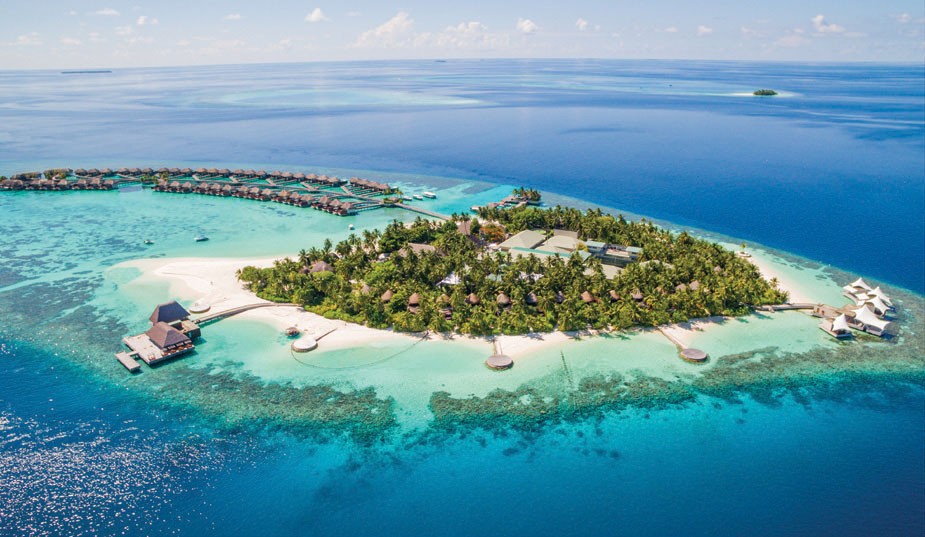 Maldives Beach Resort
Maldives Beach Resort
A tranquil scene of a Maldives beach resort showcases the pristine white sand, turquoise waters, and luxurious overwater bungalows, epitomizing the island nation’s appeal as a high-end tourist destination.
2.2. Antigua and Barbuda
Population: 101,000
GDP: $1.7 billion
Area: 440 km²
In 2022, revenue from foreign visitors equaled 55% of Antigua and Barbuda’s GDP. 265,000 people traveled to Antigua and Barbuda last year, spending $921 million. The average spend per visitor was $3,500.
Antigua and Barbuda, a Caribbean island nation, heavily relies on tourism, with 55% of its GDP coming from visitor spending. This country is known for its beautiful beaches and various vacation spots, from medium-priced to luxurious. The tourist season lasts six to seven months. Most of the country’s territory is covered by a national park. Per capita income is $31,000 (PPP), making it a country with above-average income.
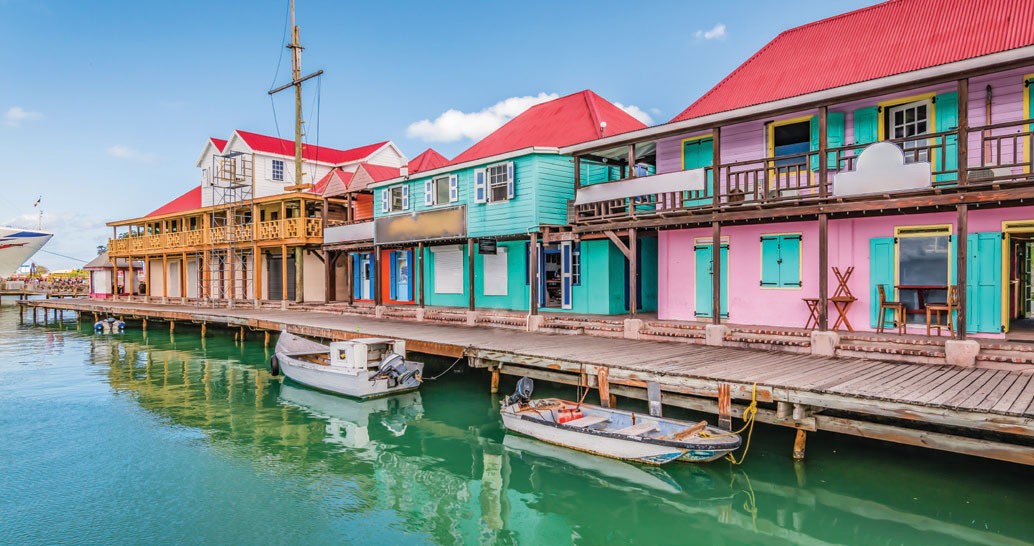 Antigua Beach Landscape
Antigua Beach Landscape
A vibrant landscape in Antigua shows a pristine beach with calm turquoise waters and lush greenery, highlighting the island’s natural beauty and appeal as a popular tourist destination.
2.3. Seychelles
Population: 100,000
GDP: $1.9 billion
Area: 457 km²
In 2022, revenue from foreign visitors equaled 23.1% of the GDP of the Seychelles. 332,000 people traveled to the Seychelles last year, spending $932 million. The average spend per visitor was $2,800.
The Seychelles, located in the Indian Ocean, earns 23.1% of its GDP from tourism. This island nation boasts year-round summer temperatures, ideal beaches, and a blend of French and English culture. It obtained independence from the UK in 1976. The official languages are French and English. The country’s beaches have everything needed for an ideal seaside holiday. The average annual income per capita is $40,000 (PPP), making it a wealthy country (around the same level as Greece).
2.4. Jamaica
Population: 2.8 million
GDP: $16 billion
Area: 10,991 km²
In 2022, revenue from foreign visitors equaled 23.1% of Jamaica’s GDP. 2.5 million people traveled to Jamaica last year, spending $3.7 billion. The average spend per visitor was $1,500.
Jamaica, another Caribbean island, sees 23.1% of its GDP supported by tourism. Its stunning beaches, warm climate, and vibrant culture attract millions of visitors annually. Jamaica attracts tourists thanks to its clear sea, hot sun and white sand. The beach season in Jamaica lasts 10 months. Besides the beaches, the best sights in Jamaica are canyons, waterfalls and forests. It obtained independence from the UK in 1962.
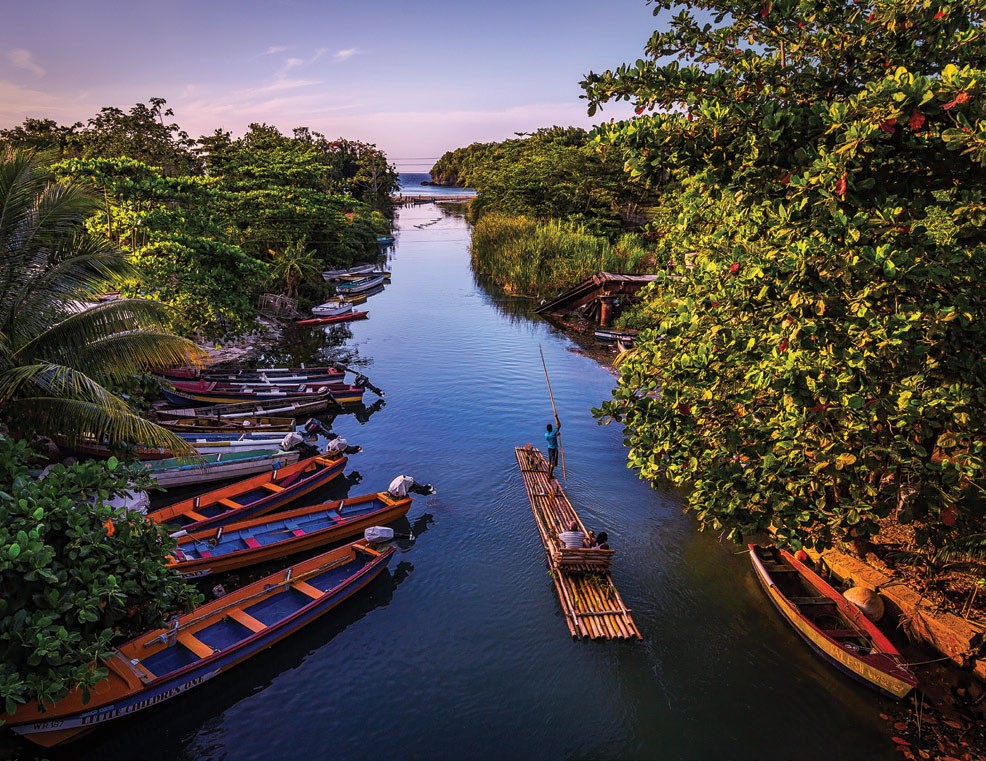 Jamaica Beach Scene
Jamaica Beach Scene
An inviting Jamaica beach scene features clear turquoise waters, white sandy beaches, and lush greenery, capturing the island’s natural beauty and its appeal to tourists seeking tropical getaways.
2.5. Belize
Population: 441,000
GDP: $3 billion
Area: 22,966 km²
In 2022, revenue from foreign visitors equaled 20.3% of Belize’s GDP. 371,000 people traveled to Belize last year, spending $600 million. The average spend per visitor was $1,620.
Belize, on the Caribbean coast, relies on tourism for 20.3% of its GDP. This country’s relatively small economy means that tourism revenues have a significant impact. The coast, the ancient Mayan temples, and the famous Blue Hole attract tourists. The average temperature in Belize varies between 24 and 28 degrees throughout the year. It obtained independence from the UK in 1981.
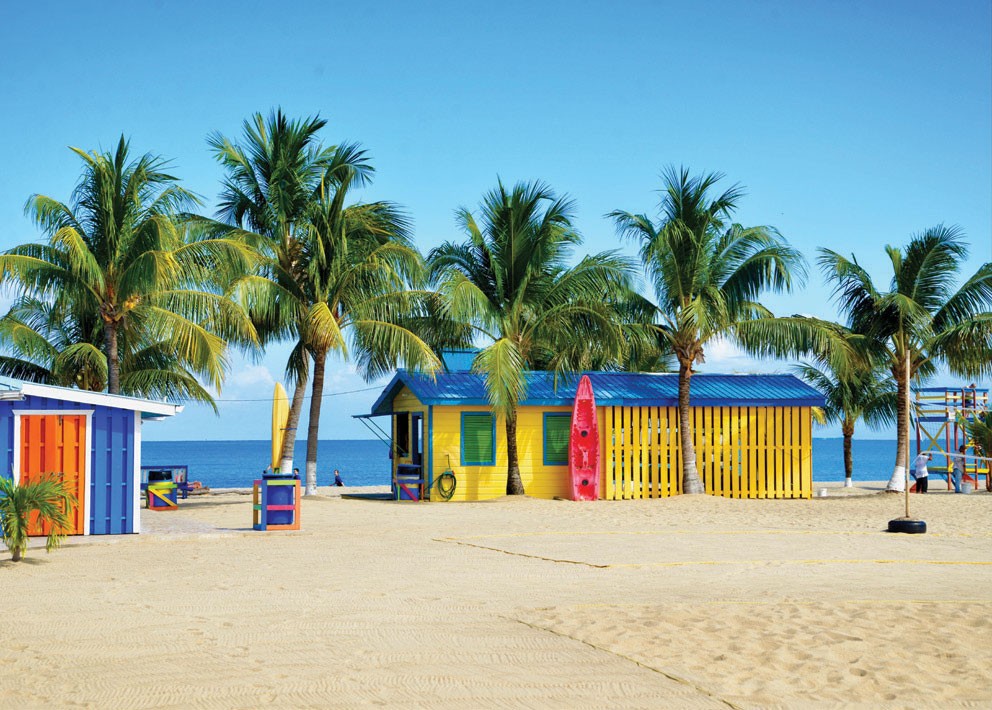 Belize Great Blue Hole
Belize Great Blue Hole
An aerial view of Belize’s Great Blue Hole shows the stunning contrast between the deep blue of the sinkhole and the surrounding turquoise waters, highlighting the area’s unique geological feature and its appeal to divers and tourists.
2.6. Croatia
Population: 3.9 million
GDP: $71 billion
Area: 56,594 km²
In 2022, revenue from foreign visitors equaled 18.9% of Croatia’s GDP. 15.3 million people traveled to Croatia last year, spending $13.5 billion. The average spend per visitor was $900.
Croatia, with its extensive coastline along the Adriatic Sea, benefits significantly from tourism, which accounts for 18.9% of its GDP. It is the most recent country to join the European Union in 2013. Per capita income is $42,500 (PPP), making it quite a rich country. In terms of revenue, it is close to Hungary and Portugal. Tourists to Croatia are attracted by the coast, which is an extension of the mountain slopes. Croatia is also distinguished by historical monuments and architecture. The Old Town of Dubrovnik is the most popular tourist destination, a UNESCO World Heritage Site. The town’s appeal to tourists increased even further after several episodes of the popular TV series Game of Thrones were filmed there.
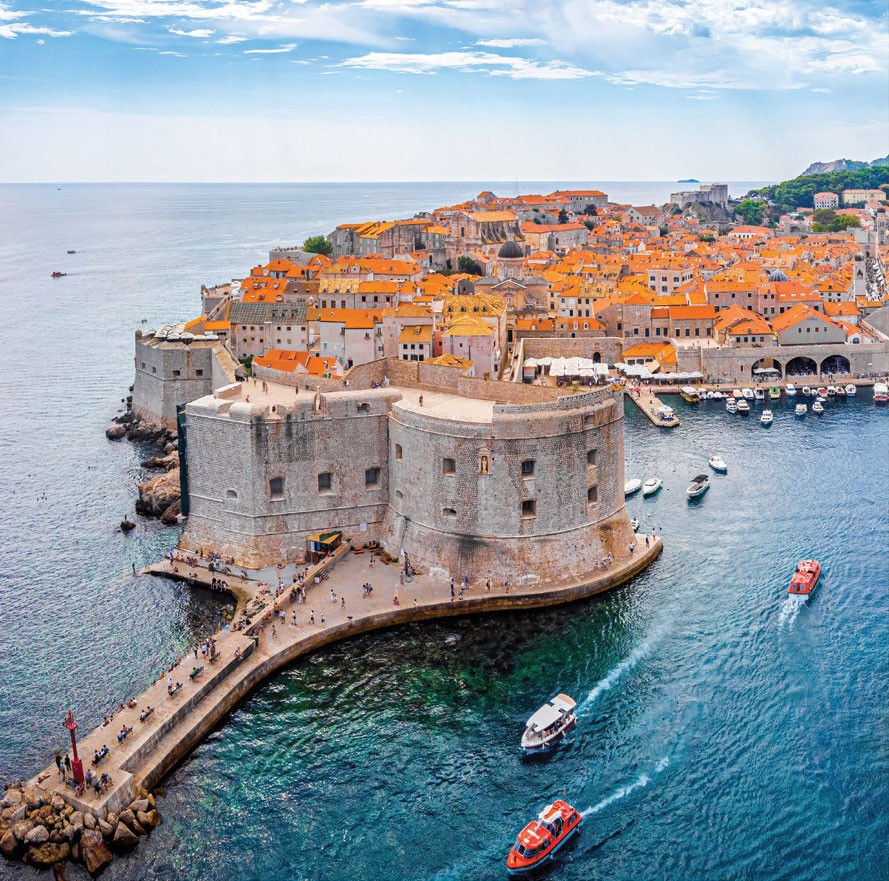 Croatia Dubrovnik Old Town
Croatia Dubrovnik Old Town
A picturesque view of Dubrovnik’s Old Town in Croatia, showcasing its historic architecture, stone buildings, and stunning coastal setting, underscores its status as a top tourist destination and a UNESCO World Heritage Site.
2.7. Montenegro
Population: 602,000
GDP: $6.1 billion
Area: 13,812 km²
In 2022, revenue from foreign visitors equaled 18.2% of Montenegro’s GDP. Two million people traveled to Montenegro last year, spending $1.1 billion. The average spend per visitor was $550.
Montenegro, located on the Balkan Peninsula along the Adriatic Sea, sees 18.2% of its GDP come from tourism. Tourists in Montenegro are attracted by the coast, which is an extension of the country’s mountain slopes. Montenegro has a 296-kilometer coastline along the Adriatic Sea, dotted with well-preserved old towns. The country is distinguished by historical monuments and architecture. Popular destinations include the 15th century settlement Sveti Stefan, which extends into the sea. Per capita income is $29,000 (PPP), making it a country with above-average income.
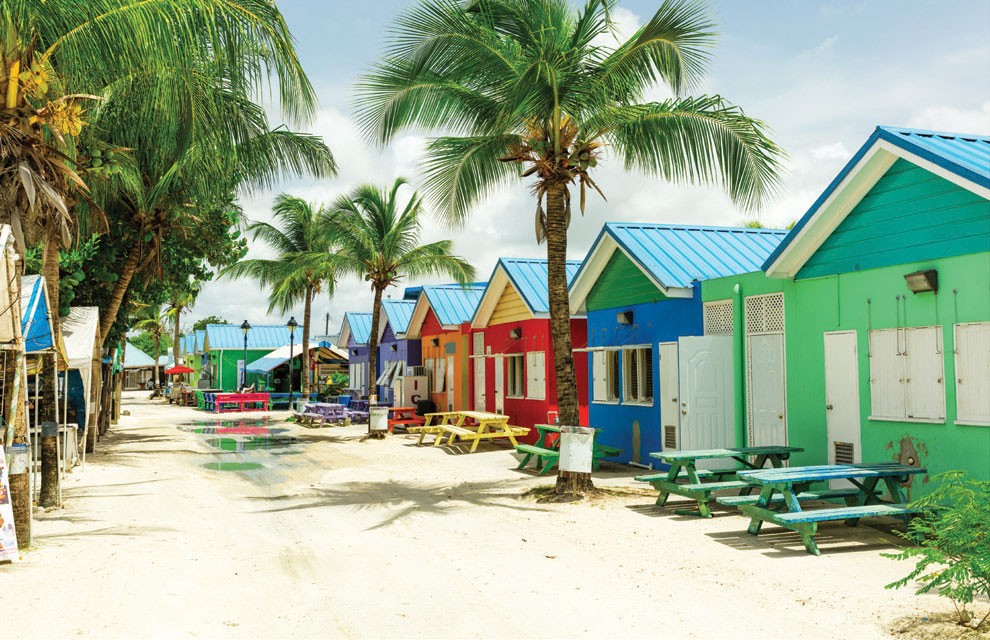 Montenegro Coastal View
Montenegro Coastal View
An impressive coastal view in Montenegro features rugged mountains meeting the clear blue Adriatic Sea, dotted with charming old towns, illustrating the country’s blend of natural beauty and historical appeal.
2.8. Barbados
Population: 268,000
GDP: $5.7 billion
Area: 439 km²
In 2022, revenue from foreign visitors equaled 16.2% of Barbados’s GDP. 443,000 people traveled to Barbados last year, spending $929 million. The average spend per visitor was $2,100.
Barbados, a Caribbean island, earns 16.2% of its GDP from tourism. With its white sand and green sea, Barbados is considered the best holiday destination in the Caribbean. The average annual income per capita is $18,000 (PPP), making it a low-income country. Barbados achieved independence from the UK in 1958. The official state language is English. The country does not attract many visitors between June and December when it frequently rains. However, the January-May dry season is ideal for seaside tourism.
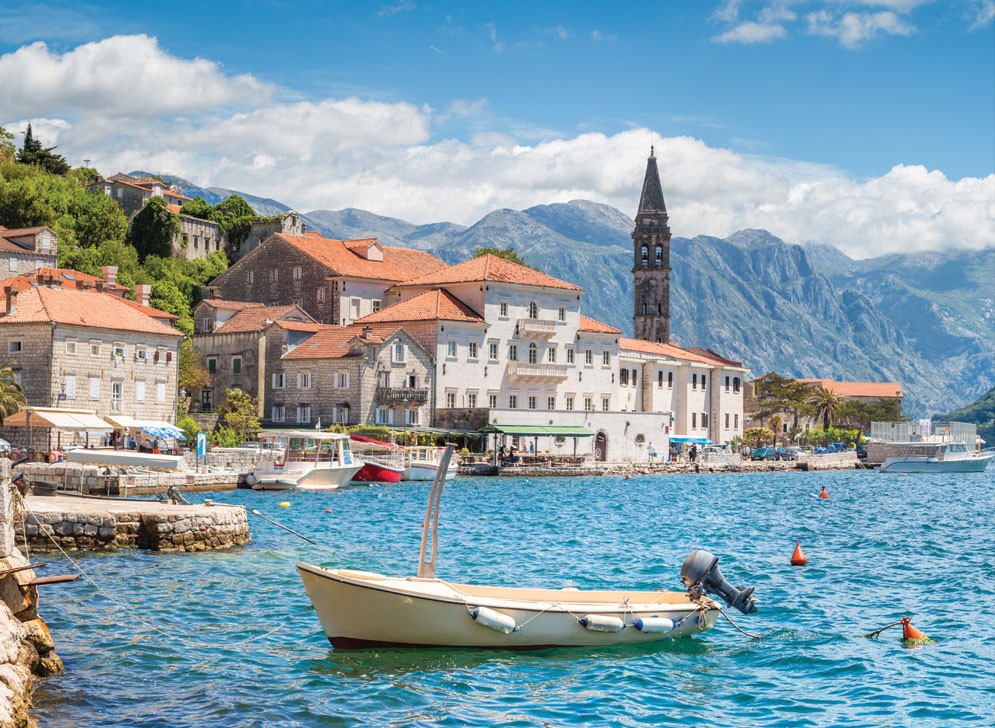 Barbados Beach Paradise
Barbados Beach Paradise
A stunning Barbados beach paradise showcases powdery white sands, clear turquoise waters, and lush tropical vegetation, highlighting the island’s idyllic scenery and its allure as a top-tier Caribbean destination.
2.9. Albania
Population: 2.8 million
GDP: $18.5 billion
Area: 28,748 km²
In 2022, revenue from foreign visitors equaled 16.2% of Albania’s GDP. 6.7 million people traveled to Albania last year, spending $3 billion. The average spend per visitor was $440.
Albania, located on the Balkan Peninsula, benefits from tourism, which contributes 16.2% to its GDP. Tourists in Albania are attracted by the beaches with white sand and clean water. The historical and archaeological monuments of Albania are also of interest. Medical tourism is also popular. Three cities in Albania are UNESCO World Heritage Sites: Butrint (an ancient Greek city), Gjirokastër (a medieval Ottoman city) and Berat (the so-called “city of a thousand and one windows”). Per capita income is $17,800 (PPP). In Europe, only Kosovo has a lower income.
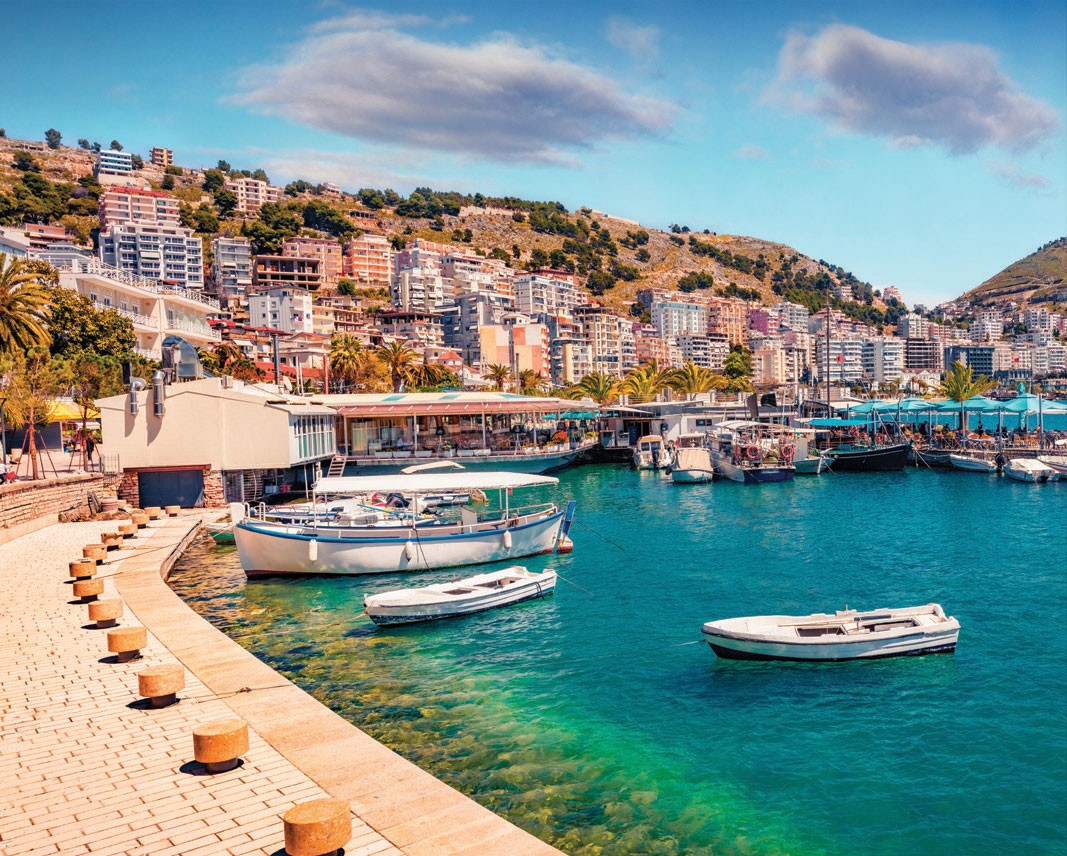 Albania Coastal Beauty
Albania Coastal Beauty
A picturesque Albania coastal beauty captures the serene blue waters of the Adriatic Sea meeting the rugged coastline, emphasizing the country’s growing appeal as a budget-friendly tourist destination with beautiful beaches and historical sites.
2.10. Fiji
Population: 926,000
GDP: $4.8 billion
Area: 18,274 km²
In 2022, revenue from foreign visitors equaled 14.33% of Fiji’s GDP. 636,000 people traveled to Fiji last year, spending $700 million. The average spend per visitor was $1,100.
Fiji, a small island country in the southwest Pacific Ocean, relies on tourism for 14.33% of its GDP. Tourists in Fiji are attracted by the fantastic beaches with white sand, palm trees and clear water. The country’s tropical forests and villages with round huts, festivities and traditions are also attractive to visitors. Fiji has a tropical climate, with an average temperature of 22 degrees, even during the coldest period. However, it also rains frequently. Fiji is a low-income country with an average annual per capita income of $14,000 (PPP). It achieved independence from the United Kingdom in 1970.
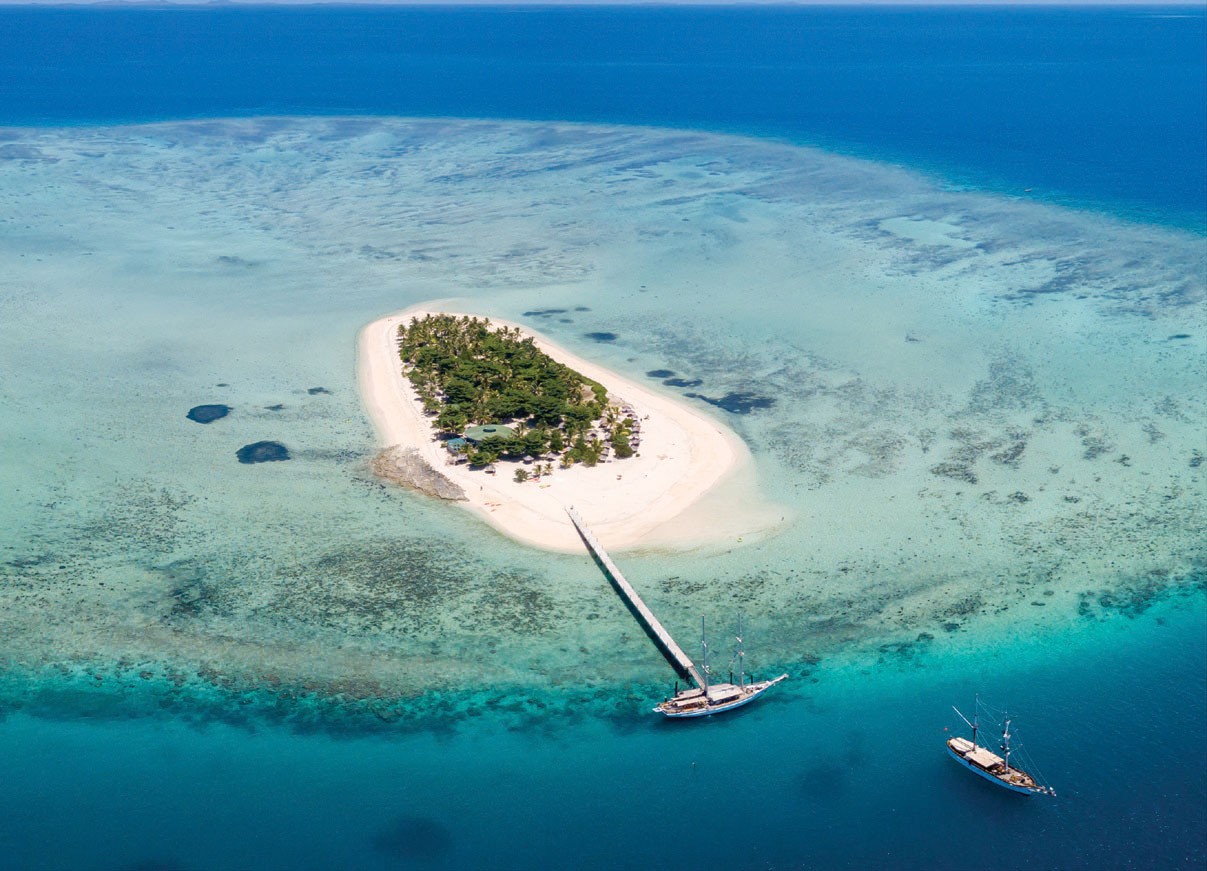 Fiji Tropical Paradise
Fiji Tropical Paradise
A captivating Fiji tropical paradise features clear turquoise waters, white sandy beaches, and lush palm trees, highlighting the island’s natural beauty and its allure as a sought-after destination for tourists seeking relaxation and adventure.
3. How Does Tourism Impact the Economy?
Tourism significantly impacts a country’s economy in several ways:
- Job Creation: The tourism sector provides numerous jobs in hotels, restaurants, transportation, and tour operations.
- Revenue Generation: Tourist spending boosts local businesses and generates tax revenue for the government.
- Infrastructure Development: To cater to tourists, countries often invest in infrastructure like airports, roads, and utilities, benefiting local communities as well.
4. What Are the Benefits of Tourism for a Country?
Beyond economic gains, tourism offers several other benefits:
- Cultural Exchange: Tourism fosters cultural exchange and understanding between visitors and local communities.
- Preservation of Heritage: Tourism can incentivize the preservation of historical sites and cultural traditions.
- Environmental Conservation: Ecotourism promotes the conservation of natural resources and biodiversity.
5. What Are the Drawbacks of Over-Reliance on Tourism?
While tourism can be beneficial, over-reliance can pose risks:
- Economic Volatility: Economic downturns or global events can significantly reduce tourist arrivals, impacting the economy.
- Environmental Degradation: Uncontrolled tourism can lead to pollution, deforestation, and damage to natural habitats.
- Cultural Disruption: Mass tourism can sometimes disrupt local cultures and traditions.
6. How Can Countries Diversify Their Economies?
To reduce dependence on tourism, countries can:
- Invest in Education and Technology: Developing a skilled workforce and promoting technological innovation can create new industries.
- Support Local Businesses: Encouraging entrepreneurship and supporting local businesses can diversify the economy.
- Develop Sustainable Industries: Focusing on industries like agriculture, renewable energy, and manufacturing can create more stable economic foundations.
7. How Does Sustainable Tourism Help?
Sustainable tourism is an approach that aims to minimize the negative impacts of tourism while maximizing its benefits:
- Environmental Protection: Sustainable tourism practices protect natural resources and reduce pollution.
- Community Involvement: Local communities are involved in tourism planning and benefit from tourism revenues.
- Cultural Preservation: Sustainable tourism respects and preserves local cultures and traditions.
8. What is the Role of the World Tourism Organization (UNWTO)?
The World Tourism Organization (UNWTO) plays a key role in promoting sustainable and responsible tourism globally:
- Data and Research: UNWTO provides data and research on tourism trends and best practices.
- Policy Advice: UNWTO advises governments on tourism policies and strategies.
- Capacity Building: UNWTO supports capacity building in developing countries to promote sustainable tourism.
9. What is Medical Tourism?
Medical tourism involves traveling to another country for medical treatment:
- Cost Savings: Medical procedures can be more affordable in some countries.
- High-Quality Care: Some countries offer world-class medical facilities and expertise.
- Shorter Waiting Times: Patients may experience shorter waiting times for treatment in other countries.
Albania is one of the countries that provide medical tourism.
10. How Can SIXT.VN Enhance Your Travel Experience in Vietnam?
SIXT.VN offers a range of services to make your trip to Vietnam unforgettable. Whether you’re traveling for leisure or business, SIXT.VN provides convenient and reliable solutions to meet your needs. With SIXT.VN, you can explore Vietnam with ease and comfort.
- Airport Transfers: Enjoy seamless and stress-free airport transfers to your hotel.
- Hotel Bookings: Choose from a wide selection of hotels to suit your budget and preferences.
- Tours: Discover the beauty and culture of Vietnam with expertly guided tours.
- Travel Advice: Get insider tips and recommendations from local experts.
Let SIXT.VN take care of the details so you can focus on creating lasting memories. Explore Vietnam’s rich history, stunning landscapes, and vibrant culture with the convenience and reliability of SIXT.VN.
SIXT.VN Services Table
| Service | Description | Benefits |
|---|---|---|
| Airport Transfers | Reliable transportation from the airport to your hotel or other destinations. | Hassle-free arrival, professional service, comfortable and safe travel. |
| Hotel Bookings | Wide range of accommodations from budget-friendly to luxury. | Convenient booking, competitive prices, variety of options to suit your needs. |
| Tours | Guided tours to explore Vietnam’s famous landmarks and hidden gems. | Expert guides, curated experiences, immersive cultural insights. |
| Travel Advice | Insider tips and recommendations to help you plan your trip. | Personalized advice, local expertise, enhanced travel experience. |
| Car Rental | Flexible car rental options for exploring at your own pace. | Freedom to travel independently, wide selection of vehicles, convenient pickup and drop-off locations. |
| Visa Assistance | Support with visa applications and requirements. | Simplified visa process, expert guidance, reduced stress. |
| Travel Insurance | Comprehensive travel insurance plans for peace of mind. | Protection against unexpected events, medical coverage, trip cancellation benefits. |
| Currency Exchange | Convenient currency exchange services for hassle-free transactions. | Competitive exchange rates, secure transactions, easy access to local currency. |
| SIM Card & Data Plans | Stay connected with local SIM cards and data plans. | Reliable internet access, cost-effective communication, easy to stay in touch with family and friends. |
| Local Transportation | Assistance with booking local transportation options like taxis, ride-sharing, and public transit. | Convenient travel within the city, access to various transportation methods, cost-effective options. |
Contact SIXT.VN Today:
- Address: 260 Cau Giay, Hanoi, Vietnam
- Hotline/Whatsapp: +84 986 244 358
- Website: SIXT.VN
FAQ Section on Countries Dependent on Tourism
1. Why are small island nations more dependent on tourism?
Small island nations often have limited economic opportunities and natural resources, making them heavily reliant on tourism for income and jobs. According to data from the World Tourism Organization, island nations frequently leverage their beaches, climate, and unique cultures to attract visitors.
2. How does tourism contribute to a country’s GDP?
Tourism contributes to a country’s GDP through direct spending by tourists on accommodations, food, transportation, and activities. It also generates indirect revenue through the supply chain, as businesses that serve tourists purchase goods and services from other local companies.
3. What are the negative impacts of tourism on dependent countries?
Over-reliance on tourism can lead to economic instability, environmental degradation, and cultural disruption. Economic downturns, natural disasters, or global events like pandemics can severely impact tourism-dependent economies, as noted by a UN report on sustainable tourism.
4. What measures can countries take to diversify their economies and reduce dependence on tourism?
Countries can diversify their economies by investing in education, technology, and infrastructure, as well as supporting local businesses and developing sustainable industries. The World Bank suggests focusing on sectors like agriculture, renewable energy, and manufacturing to create more stable economic foundations.
5. How does sustainable tourism help countries balance economic benefits with environmental and cultural preservation?
Sustainable tourism aims to minimize negative environmental and cultural impacts while maximizing economic benefits for local communities. According to the UNWTO, this involves practices such as eco-friendly accommodations, responsible tour operations, and community-based tourism initiatives.
6. What is the role of international organizations in promoting sustainable tourism?
International organizations like the UNWTO and UNESCO play a crucial role in promoting sustainable tourism by providing data, policy advice, and capacity-building support to governments and tourism stakeholders. These organizations also help to establish standards and guidelines for sustainable tourism practices.
7. How has the COVID-19 pandemic affected tourism-dependent countries?
The COVID-19 pandemic has had a devastating impact on tourism-dependent countries, leading to significant declines in tourist arrivals and revenue. According to the UNWTO, many countries experienced drops of 70-80% in international tourist arrivals, resulting in massive job losses and economic hardship.
8. What is the future of tourism in countries that are heavily dependent on it?
The future of tourism in dependent countries involves adopting more sustainable and resilient approaches. This includes diversifying tourism products, investing in health and safety measures, and promoting domestic tourism to reduce reliance on international visitors.
9. Which regions are most vulnerable due to their reliance on tourism?
Small island developing states (SIDS) in the Caribbean and Pacific, as well as countries in Southeast Asia and the Mediterranean, are particularly vulnerable due to their high dependence on tourism. These regions often face additional challenges such as climate change, natural disasters, and limited resources.
10. What alternative economic activities can tourism-dependent countries develop?
Tourism-dependent countries can explore alternative economic activities such as renewable energy, sustainable agriculture, fisheries, and creative industries. Investing in these sectors can help diversify their economies, create new jobs, and reduce their vulnerability to external shocks.
By understanding the factors that make a country dependent on tourism, the benefits and drawbacks of this reliance, and the strategies for diversification and sustainability, you can gain a deeper appreciation of the complex relationship between tourism and economic development.



